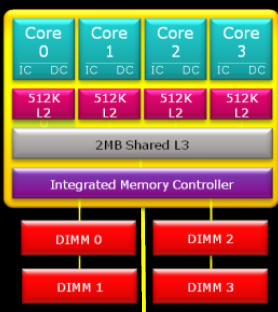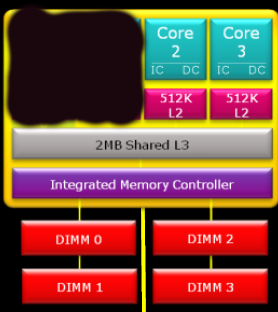Let me show you a magic trick
Here's a magic trick: turning a Phenom into an Athlon
The long-serving AMD Athlon continues to ply the value end of the market, but it has been usurped by triple- and quad-core Phenom processors in the performance stakes. Phenoms are plain better than Athlons for a number of reasons, including a smattering of L3 cache, multimedia optimisations, and faster IO. There's other magic sauce inside, too, that makes them faster clock-for-clock CPUs, but you wouldn't want to know all about tuning the branch-prediction unit, would you?
We've been waiting a while for a dual-core, Phenom-derived CPU to hit the retail shelves, and the wait, in part at least, has been down to how AMD can justify hewing a dual-core CPU from a monolithic die that's wholly architected for quad-core processing.
Want to know what I'm bleating on about? Take a look at a stupidly simple block diagram of the current Phenom die.

How do you chop that up so that there's dual-core processing? The answer is deceptively simple, it turns out, because AMD's keeping the same die and disabling a couple of cores that a) either don't work as intended or b) to simply push dual-core 'Phenoms' out of the door. This is the same policy adopted with the release of tri-core models, as well.
A Phenom in all but name
So what you have is full-fat Phenom die, weighing in at some 450m transistors and taking up 285mm², but limited to two cores. Using world-class engineering tools, here's the dual-core Phenom (ahem, Athlon).

AMD's design team would probably like to take a hammer to my soft bits for completely underestimating and deprecating what's involved, but this is what the dual-core CPU is. Want to know more about the underlying architecture, feel free to consult the original article here.
The pragmatism of it
As far as we can tell, the 65nm CPUs are otherwise identical to their also-65nm Phenom counterparts, so 64KB of L1 instruction and data cache per core, 512KB of L2 cache per core, and 2MB of L3 cache shared amongst both cores. No Shanghai/Deneb-based goodness has seeped through here, it seems.
The integrated memory-controller, which can group two 64-bit channels in a 128-bit-wide pathway, works at an effective 1.8GHz, which is also the speed of the L3 cache - a foible kept over from the Phenom design, evidently.
Based on the common AM2+ socket, users should be able to drop-in the processor with just a BIOS update, and the built-in HyperTransport link will provide speedy transfers to the rest of the system.
The processor also carries the Phenom's more-granular power-management feature-set (how many hyphens?) that, compared to Athlon, should provide better power profiles when CPU load changes from one second to the next.
Interestingly, a Phenom-derived Athlon - a 2.3GHz-clocked 6500+ model - has already been spotted in the wild, with promising benchmarks to boot.
Basic thoughts
Honestly, we don't care how AMD's managed to get a dual-core model out of a quad-core design; that's a decision for the company to make, and it beats a grounds-up design for sheer time-to-market, obviously.
The new dual-core chips won't be called Phenoms, strangely, because that will probably be viewed as dilution of the performance brand. Rather, currently referred to by the codename Kuma, they're to be known as Athlon X2 7000 series, and the original batch will comprise of two models - the 2.5GHz X2 7550 and 2.7GHz 7750 Black Edition.









